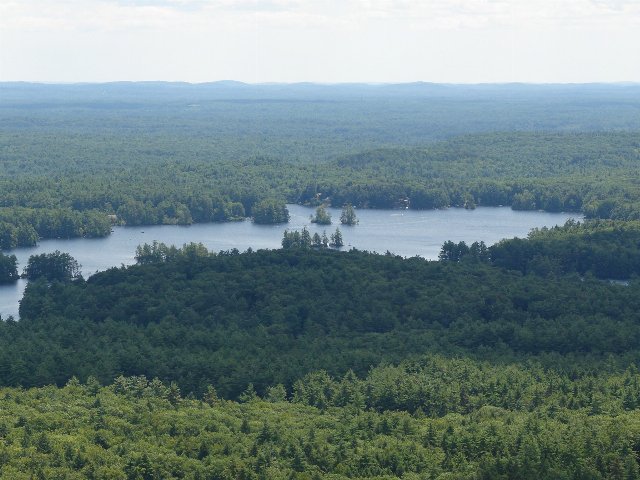Home » Regions » North America » Eastern Temperate Forests » Mixed Wood Plains » Northeastern Coastal Zone » Gulf of Maine Coastal Plain
Gulf of Maine Coastal Plain
Last updated: November 12th, 2021
Page contents
↑About the Gulf of Maine Coastal Plain
The Gulf of Maine Coastal Plain is a somewhat rugged, irregular coastal plain that lies between the coastal lowlands and more mountainous interior areas. It stretches from a large portion of eastern Massachusetts, north into southeastern New Hampshire, and into southwestern Maine.The topography consists of rolling hills, some of which can reach quite high, with local relief of 200-400 feet. Most of the region is 100 and 600 ft in elevation, but scattered peaks reach up to 1159ft. Glacial drumlins are common, and there are some glacial lakes, ponds, and wetlands. The underlying bedrock is mostly metamorphic rocks, including both metasedimentary and metavolcanic rocks, with a small amount of granite.
This region has a humid continental climate with high rainfall, roughly equally distributed througohut the year. The frost-free growing season is 130-160 days, only slightly shorter than the coastal area, but much shorter than that in the Boston Basin, and significantly longer than areas farther inland.
Natural forest cover is Appalachian oak-pine forest, including northern red oak (Quercus rubra), white oak (Quercus alba), black oak (Quercus velutina), with some scarlet oak (Quercus coccinea) and chestnut oak (Quercus montana) in the more southerly regions, and also eastern white pine (Pinus strobus), sugar maple (Acer saccharum), red maple (Acer rubrum), various hickories, and some other hardwoods. There is also some hemlock-hardwood-pine forest, featuring eastern hemlock (Tsuga canadensis), sugar maple, white ash (Fraxinus americana), yellow birch (Betula alleghaniensis), American beech (Fagus grandifolia), black cherry (Prunus serotina), northern red oak, and eastern white pine. In these forests, some chestnut oak occurs on ridges and hilltops. Floodplain forests and bottomlands featured silver maple (Acer saccharinum), American elm (Ulmus americana), and green ash (Fraxinus pennsylvanica).
This area is currently mostly forested, nearly all second-growth forest after the area was cleared for farming. Like most of New England, agriculture has declined and all but a small amount of cropland and pastureland has been abandoned. Although less populous than the Boston metro area to the northeast, this region is moderately urbanized, much more so than areas to the north and west. It contains the four largest cities in New Hampshire, and in Massachusetts, it contains Worcester, Lowell, Lawrence, and many smaller cities.
The natural forest composition in floodplains is now threatened by the potential loss of green ash as the Emerald Ash Borer spreads into this region.
This region is bordered to the southeast, along the coast, by the Gulf of Maine Coastal Lowland. At its southern end, it is bordered to the southeast by the heavily urbanized Boston Basin, and to the south by the more rural Southern New England Coastal Plains and Hills, and to the west by the Lower Worcester Plateau/Eastern Connecticut Upland. The northernmost portion of this region, in Maine, is bordered to the northwest by the colder, more rugged and upland Sebago-Ossipee Hills and Plains. The rest of the region is bordered to the northwest by the also colder and more upland, but relatively flatter Worcester/Monadnock Plateau.
 This photo, showing Pawtuckaway lake in New Hampshire, shows the landscape at the beginning of the Gulf of Maine Coastal Plain, taken from South Mountain just outside of the region. The region is mostly forested, hilly in places, and has some lakes. This image is a crop of a photo © codymcarlson (Flickr), CC BY-SA 2.0, Source.
This photo, showing Pawtuckaway lake in New Hampshire, shows the landscape at the beginning of the Gulf of Maine Coastal Plain, taken from South Mountain just outside of the region. The region is mostly forested, hilly in places, and has some lakes. This image is a crop of a photo © codymcarlson (Flickr), CC BY-SA 2.0, Source.Plant Lists & In-Region Search
We do not yet have data to generate plant lists for a region as fine-tuned as this one. However you can move up to the broader Northeastern Coastal Zone and generate lists for that region: native plants or all plants. Or search that region's plants here:
↑References
1. Griffith, G.E., Omernik, J.M., Bryce, S.A., Royte, J., Hoar, W.D., Homer, J.W., Keirstead, D., Metzler, K.J., and Hellyer, G. "Ecoregions of New England (Poster)", U.S. Geological Survey (2009) Web.


